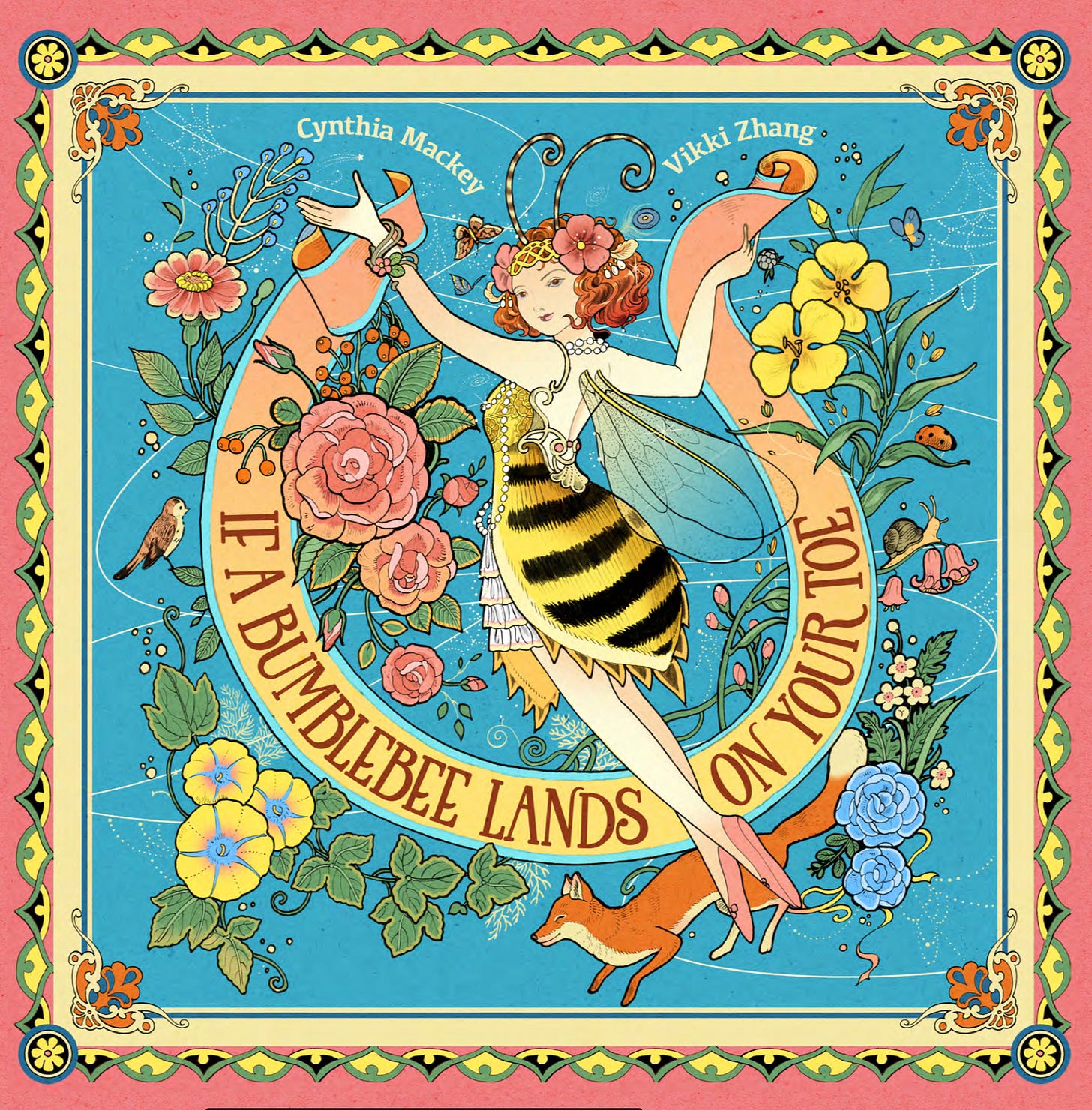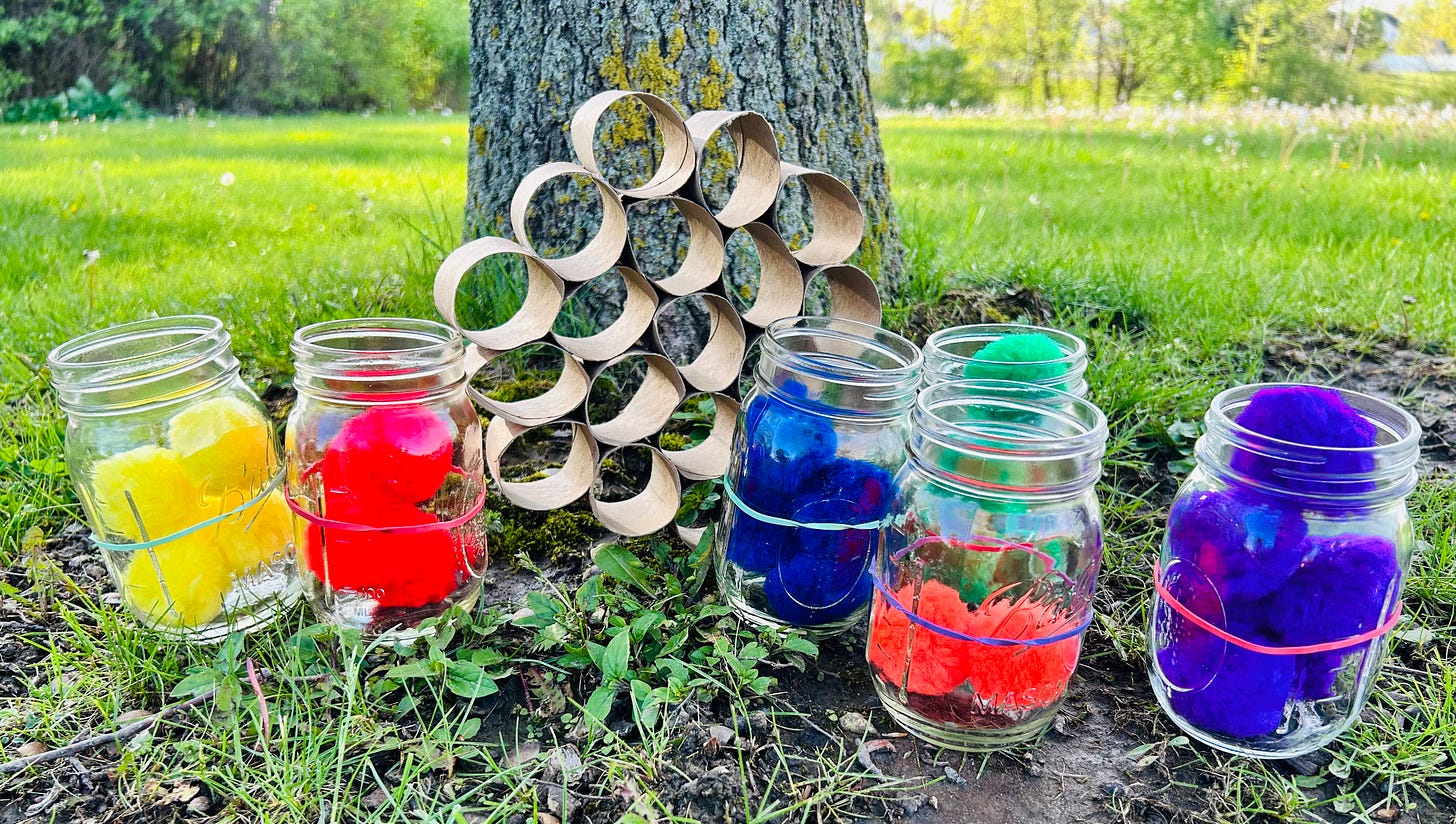Growing Empathy Through Stories, Stones, & Sticks - Part 3
When a bumblebee provides a lesson in compassion.
When I was little, I spent hours playing in the trees behind my house, searching for secret nooks and crannies where fairies and elves might be hiding. I didn’t care if I walked into the house with mud under my nails and leaves in my hair.
Until the day a bumblebee appeared. And chased me in (what felt like) a slow-motion pursuit. I’m not sure I ever pedaled my little legs so fast to get inside. When I finally reached the front door, I dove inside to escape the culprit that would surely give me a painful sting.
I wonder how that moment might have gone if I had a little more composure. A pause to breathe, to observe, to notice what was actually happening…just a curious bee going about its day.
That fear was real. And for little ones, the simple hum of wings can send them beelining in the opposite direction. (Unless you’re my toddler who thinks fuzzy bumblebees are just asking to be petted.)
Our kids are learning how to respond to the world by watching us. They take in how we pause, how we notice, how we stay curious, how we thoughtfully respond…and how we react with emotion.
This is exactly why I love If a Bumblebee Lands on Your Toe. Beautifully written by Cynthia Mackey, and illustrated by Vikki Zhang, it’s a gentle, poetic guide to meet the world with calm curiosity - even when our instincts say panic and run.
If a bumblebee lands on your toe…Breathe.
Sl-owwww-ly,
like a garden snail
inching under a daisy on a rainy day.
If A Bumblebee Lands On Your Toe invites readers to channel their inner “creature, great, and small, wise, and peaceful.” To feel “brave, ever so brave” in moments that make us want to panic.
The text is soothing and poetic, filled with similes to help young readers connect with the world around them. It reminds readers that we can become curious. We can pause, notice, and breathe like the creatures around us, and find calm in the chaos.
And the illustrations! They are intricate and stunning. They depict a “theater of the mind,” which feels wonderfully in tune with the way a child sees the world. Filled with wonder and imagination, the illustrations complement the text beautifully.
Mindfulness and compassion are gifts we can pass along. Be sure to check out this book when it releases on May 20th from Yeehoo Press.
Invitation to Play
Bee Breath
Children respond beautifully to simple mindfulness tools. Before you begin the movement activity below, guide your child in taking a “bee breath.” This calming breathing exercise mimics the gentle hum of a buzzing bee - perfect for using whenever a little calm is needed.
How to do it:
Take a deep breath in through the nose. As you exhale, hum gently like a buzzing bee, “Mmmmmmm….” It’s a sweet way to create a moment of mindfulness (and maybe a giggle or two) together.
Let’s Bee Friends
This activity is perfect for kids with lots of wiggles to spare! Let’s Bee Friends invites children to work together like a busy hive searching for flowers, gathering “nectar,” and delivering it back to their shared honeycomb, just like real bees.
Through imaginative role-play, children practice empathy by slipping on the wings of a tiny creature that’s often misunderstood or feared. They begin to see how all living things are connected, and how caring for even the smallest beings helps build a more compassionate world.
Here’s what you need:
Honeycomb - choose from:
Create your own with toilet paper tubes (cut in half and glue together in a honeycomb shape)
Bowl or jar as a simple hive stand-in
Flowers
Several mason jars, cups, or small containers, depending on how many flowers you want to have
Nectar - choose from:
Pom Poms
Colored water
Lentils or dried beans
Nature treasures (leaves, pebbles, petals, pinecones, etc.)
Tools for collecting nectar
Tweezers, tongs, or spoons (for solid nectar)
Pipette or spoons (for liquid nectar)
Here’s what you do:
Collect your materials. Create your honeycomb and gather your nectar materials.
Fill the flowers. Add a small amount of nectar to each container.
Scatter the flowers. Spread them out in a grassy area, garden, or play room. For older children, consider hiding a few to mimic the search bumblebees must do when flowers are scarce.
Share If A Bumblebee Lands On Your Toe by Cynthia Mackey and Vikki Zhang.
Explore a few wonderings.
I wonder why that bee landed on her toe.
I wonder what bees need to thrive.
I wonder how other animals react when a bee lands on them.
I wonder why bees are so important to our world.
Time to play. Each child becomes a busy bumblebee, searching for nectar, gathering it with their tool, and bringing it back to the hive. Hand each child a tool and let the pollinating fun begin!
Keep the Fun Going
Add movement. Bumblebees perform a “waggle dance” to show other bees where to find the best nectar. (See It Starts with a Bee by Aimee Gallagher in the book recommendations) Invite children to create their own version—wiggling, dancing, and buzzing as they guide their teammates to hidden flowers. It’s a fun way to build teamwork, burn off extra energy, and stir up some giggles!
Turn this into a sensory bin. My toddler loved using the tweezers to pick up Pom Poms and drop them into the toilet paper tubes, so we turned it into a sensory bin! It’s a great way to support hand-eye coordination and fine-motor skills for little ones.
Craft Corner
Bumblebee Bath
Bumblebees work tirelessly every day, flying from flower to flower and back to their hive to pollinate plants and support our ecosystems. On hot days, they can get exhausted and dehydrated. Offering a simple water source can give these buzzy little workers the refreshment they need (and they won’t mind if it isn’t too fancy).
Here’s what you need:
A shallow dish, bowl or saucer (avoid plastic)
A few rocks, pebbles, and/or stones
Clean water
Here’s what you do:
Start with a story to spark empathy. Share Please Please the Bees by Gerald Kelley. This story is a wonderful way to introduce that bees, like us, need water, food, and a safe place to live. Talk about how we can show kindness and compassion by helping bees meet their basic needs - especially on hot days when they might be tired and thirsty.
Fill the dish with rocks. These will be safe landing spots, giving bees a place to rest and drink without the risk of drowning.
Add just enough water to cover the bottom of the rocks. Ensure there is enough dry surface for the bees to perch on.
Tips
Change the water regularly to discourage mosquitos.
Place the bath in a shady spot to keep the water cool and inviting (even if the photo above ignores this!).
Place the bath near flowers so bees can easily find it.
Book Recommendations
⭐️ Book mentioned in Invitation to Play
🌼 Book mentioned in Craft Corner
Lights Out: A Movement to Help Migrating Birds by Jessica Stremer, Art by Bonnie Pang:
A beautiful and inspiring call to action that shines a light on the important work being done to protect our planet’s winged travelers. This nonfiction book showcases how even our youngest friends can make a big difference in our community.
The Circles All Around Us by Brad Montague, Art by Brad and Kristi Montague:
This book encourages young readers to extend compassion beyond themselves and see how small acts of kindness ripple outward. Whether through a shared smile, a kind word, or "friendship donut," it shows we all have the power to make an impact.
Hey, Little Ant by Phillip and Hannah Hoose, Art by Debbie Tilley:
“To squish, or not to squish?” That’s the moral dilemma at the heart of this tale. When a boy spots an ant on the sidewalk, he’s ready to squish it … until the ant speaks up, asking the boy to imagine life from his tiny perspective.
🌼 Please Please the Bees written and illustrated by Gerald Kelley:
Meet a bear who loves his daily honey delivery from a hardworking hive of bees. But when the bees go on strike, he’s forced to wonder if he’s been taking their efforts for granted. Readers will enjoy the bear’s transformation as he learns the importance of doing his part.
⭐️ It Starts With a Bee by Aimee Gallagher, Art by Jennie Webber:
Follow a bee as it dances from flower to flower and back to the hive, an engaging and informative glimpse into the role bees play in pollination. With gentle rhyme and vibrant art, this nonfiction book is perfect for sparking compassion for nature and its pollinators.
Brave Baby Hummingbird by Sy Montgomery, Art by Tiffany Bozic:
A breathtaking journey that follows two orphaned hummingbirds as they fight for survival and discover their strength. This is a true story based on two rescued hummingbirds. The author seamlessly weaves facts throughout the story in a way that feels natural and engaging, making this book an educational treasure.
Milkweed for Monarchs by Christine Van Zandt, Art by Alejandra Barajas:
A stunning celebration of one of nature’s most iconic insects. This beautifully illustrated nonfiction picture book guides readers through the life cycle of a monarch butterfly. With its gentle rhythm and heartfelt message, this book is a valuable educational resource as well as an engaging read-aloud.
Honeybee: The Busy Life of Apis Mellifera by Candace Fleming, Art by Eric Rohmann:
Honeybee offers a captivating glimpse into the world of honeybees. Written with immersive, lyrical prose and lifelike illustrations, readers are pulled into a buzzing hive, following the remarkable journey of a single bee through her brief but vital life.
That’s a Wrap
This post brings our empathy series to a close. I truly hope the stories, activities, and book recommendations have sparked meaningful moments with the children in your life. These resources are evergreen, so feel free to revisit them anytime, and I’d love to hear how they worked for you. Share your experiences (photos welcome!), and I’ll be sure to respond.
Find the previous posts in this series here:
Growing Empathy Through Stories, Stones, & Sticks - Part 1 (Empathy)
Growing Empathy Through Stories, Stones, & Sticks - Part 2 (Emotional growth)
Chat with the Grove
I’ve activated our chat feature! I’m excited for the opportunity to bring the KidLit Grove community closer together and connect with you. Whether you need some quick support on activities, advice on substitutions for materials or adaptations, book recommendations, or are simply hoping to connect with others who are in the same season - this space will offer that.
What’s Next
June 5th is World Environment Day! We’ll explore what this day is all about, and how even our youngest kids can learn to appreciate our planet through rich sensory experiences.
Thank you for being part of this journey toward raising kinder, more mindful kids. ❤️










